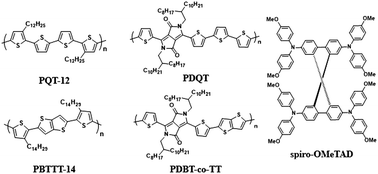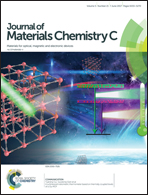Thiophene and diketopyrrolopyrrole based conjugated polymers as efficient alternatives to spiro-OMeTAD in perovskite solar cells as hole transporting layers†
Abstract
Poly[(5,5′-bis(3-dodecyl-2-thienyl)-2,2′-bithiophene)] (PQT), poly-(2,5-bis(3-alkylthiophene-2-yl)thieno[3,2-b]thiophene) (PBTTT), poly{2,2′-[(2,5-bis(2-octyldodecyl)-3,6-dioxo-2,3,5,6-tetrahydropyrrolo[3,4-c]pyrrole-1,4-diyl)]dithiophene-5,5′-diyl-alt-2,2′-bithiophene-5,5′-diyl} (PDQT) and poly{2,2′-[(2,5-bis(2-octyldodecyl)-3,6-dioxo-2,3,5,6-tetrahydropyrrolo[3,4-c]pyrrole-1,4-diyl)]dithiophene-5,5′-diyl-alt-thieno[3,2-b]thiophene-2,5-diyl} (PDBT-co-TT) were used to replace spiro-OMeTAD as efficient hole transporting layers (HTLs) in perovskite solar cells (PSCs). We demonstrated that both the hole mobility and suitable energy levels of these polymers are important factors in PSCs using organic field-effect transistors (OTFTs) and cyclic voltammetry analysis. The doping effect and the hydrophobic properties of the HTLs were investigated using atomic force microscopy (AFM) and water contact angle measurements. The results show that the PBTTT-14 and PDBT-co-TT based PSCs showed the best PCE of 14.1% and 12.0%, respectively when compared with spiro-OMeTAD based PSCs which have a PCE of 10.2%.



 Please wait while we load your content...
Please wait while we load your content...